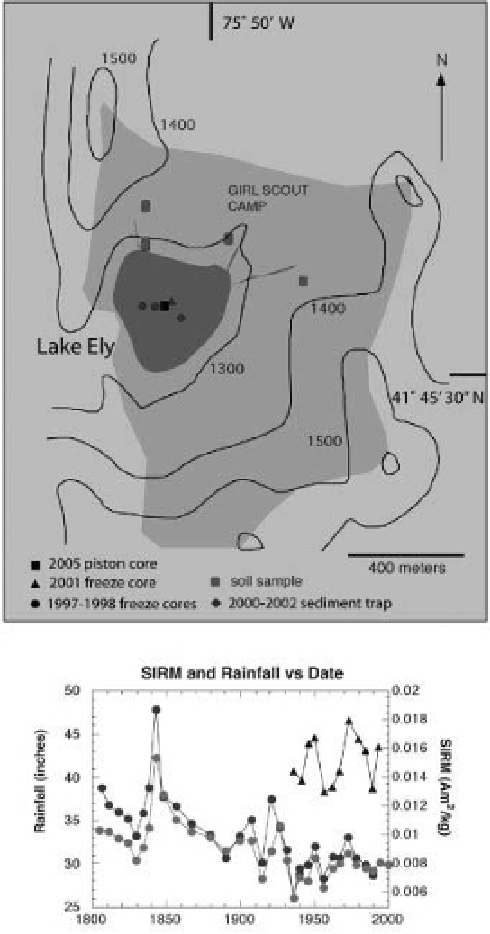Geology Reference
In-Depth Information
same quantum mechanical sub-atomic processes
as for larger magnetically stable grains, but only
holds its direction for short periods of time (< several
minutes) and reacts to applied fi elds similar to para-
magnetic materials. Superparamagnetic grains there-
fore contribute to the susceptibility of a substance. The
susceptibility of superparamagnetic grains can be
detected by applying alternating magnetic fi elds at
different frequencies. Both Tauxe (2010) and Butler
(1992) provide excellent and detailed accounts of
superparamagnetism.
Pertinent to the theme of this topic is the considera-
tion of whether the magnetosomes generated by mag-
netotactic bacteria contribute to the paleomagnetic
remanence of a sediment or a sedimentary rock. The
magnetofossils created by magnetotactic bacteria are
found in many environments: lake sediments, hemipe-
lagic marine sediments, deep-sea sediments, ancient
limestones as far back as the Precambrian and even in
Chinese loess (Chang & Kirschvink 1989; Evans &
Heller 2003). As early as the 1980s, workers recog-
nized that magnetosomes could become oriented by
post-depositional processes to carry a strong paleo-
magnetic signal (Petersen
et al.
1986). In a recent
study Kobayashi
et al
. (2006) found that magnetosome
chains maintained their linearity even after the cell
walls surrounding the chains had been disrupted.
Through TEM observations they found an intracellular
organic sheath that may be responsible for stabilizing
the chain structure. If chains could remain intact, or
at least partially intact, they could provide strong,
stable NRMs in marine and lake sediments. In fact,
Roberts
et al.
(2011) recently provided evidence of
bacterial magnetite preserved in Eocene pelagic car-
bonates from the southern Kerguelen Plateau, domi-
nating their paleomagnetic signal. The chemical
conditions were apparently just right in these organic-
poor carbonate-rich pelagic sediments for magnetotac-
tic bacteria to be present, but not dissolved after
deposition by sulfate reduction diagenesis.
The importance of magnetosomes, produced in
recent lake sediments, to the environmental magnetic
record can be shown in detail from an environmental
magnetic study of Lake Ely. In this study environmen-
tal magnetic parameters can be used to characterize
the magnetic properties of the lake sediments and
learn something about past environmental conditions
in the lake and its watershed. The closest similar study
is that of Salt Pond in Massachusetts (Moskowitz
et al.
2008) but Salt Pond, as is obvious from its name, has
very saline waters. By contrast, Lake Ely is a typical
freshwater lake from glaciated terrain in north-eastern
Pennsylvania (41.760 ° N, 75.835 ° W, 380 m elevation;
Fig. 8.6). The lake is relatively deep (24 m) surrounded
by steep topography and has a small watershed. The
Fig. 8.6
Location map for Lake Ely in northeastern
Pennsylvania and correlation between IRM intensity of
recent lake sediments and local historical rainfall record.
Red and blue circles indicate SIRM intensity for lake
sediment samples collected at two successive years. Triangles
show local historic rainfall measured near the lake.
(See Colour Plate 16)





Search WWH ::

Custom Search